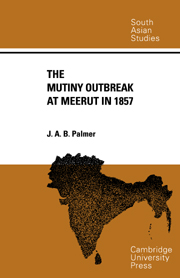Book contents
- Frontmatter
- Contents
- Introduction
- 1 CHAPĀTĪS
- 2 GREASED CARTRIDGES
- 3 THE PRESIDENCY DIVISION, FEBRUARY TO MAY
- 4 REGIMENTS AND OFFICERS AT MEERUT
- 5 MEERUT CANTONMENT IN 1857
- 6 THE FIRING PARADE OF 24 APRIL AND ITS SEQUEL
- 7 THE OUTBREAK: (a) The Native Infantry Lines
- 8 THE OUTBREAK: (b) The Native Cavalry Lines
- 9 THE OUTBREAK: (c) The Bazar Mobs
- 10 THE OUTBREAK: (d) The European Troop Movements and the European Lines
- 11 THE HANDLING OF THE EUROPEAN TROOPS
- 12 TO DELHI
- 13 CONCLUSIONS
- Notes and References
- Index
- Plan of Meerut Cantonment in 1857
3 - THE PRESIDENCY DIVISION, FEBRUARY TO MAY
Published online by Cambridge University Press: 24 October 2009
- Frontmatter
- Contents
- Introduction
- 1 CHAPĀTĪS
- 2 GREASED CARTRIDGES
- 3 THE PRESIDENCY DIVISION, FEBRUARY TO MAY
- 4 REGIMENTS AND OFFICERS AT MEERUT
- 5 MEERUT CANTONMENT IN 1857
- 6 THE FIRING PARADE OF 24 APRIL AND ITS SEQUEL
- 7 THE OUTBREAK: (a) The Native Infantry Lines
- 8 THE OUTBREAK: (b) The Native Cavalry Lines
- 9 THE OUTBREAK: (c) The Bazar Mobs
- 10 THE OUTBREAK: (d) The European Troop Movements and the European Lines
- 11 THE HANDLING OF THE EUROPEAN TROOPS
- 12 TO DELHI
- 13 CONCLUSIONS
- Notes and References
- Index
- Plan of Meerut Cantonment in 1857
Summary
The earliest reactions to the affair of the greased cartridges occurred swiftly both at Barrackpore, the cantonment which was the headquarters of the Presidency Division of the Army near Calcutta, and also at other stations in that Division. Historians of the Mutiny have discussed at some length whether it is true that cartridges were manufactured at Dum-Dum or elsewhere in India with the use of grease made from the fat of cows or pigs. Kaye answered the question in the affirmative and Holmes could not quite get away from the fact, though he insisted that it was not proved. It really does not matter much: here, if ever, is a case where what matters is not reality but appearance, not truth but opinion, not even fire but only smoke—and in the end possibly paper more than grease.
As described in the previous chapter, the khalāsi incident was reported to Government by Major-General Hearsey commanding the Presidency Division and the problem of the grease was considered by Colonel Abbot, the Inspector-General of Ordnance. On Government's orders, Hearsey issued instructions for Dum-Dum on 28 January, directing that the greasing materials should be bought in the bazar and made up by the men.
On 28 January also, Hearsey further reported to Government an ill-feeling in the minds of the sepoys at Barrackpore: he attributed it to agents of the ‘religious Hindu party in Calcutta (I believe it is called the Dhurma Sabha)’ who were telling the sepoys that they would be forced to embrace the Christian faith.
- Type
- Chapter
- Information
- The Mutiny Outbreak at Meerut in 1857 , pp. 21 - 33Publisher: Cambridge University PressPrint publication year: 1966



